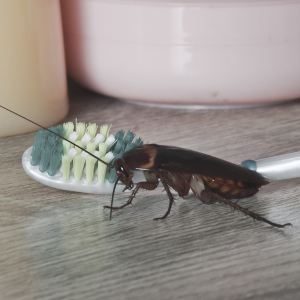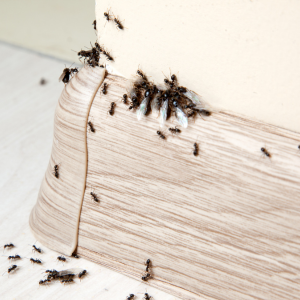


Introduction
As the temperature begins to drop, the warm, inviting atmosphere inside our homes becomes an ideal refuge not just for us but also for an array of pests. Winter is the season when many insects, rodents, and other pests actively seek out cozy, protected spaces to hunker down, making our homes an attractive shelter from the harsh outdoor conditions. For pests, the appeal of a warm house lies in more than just the temperature; they are drawn to easy access to food, water, and nesting spots that our homes inadvertently provide. This seasonal migration indoors can lead to a host of issues, from health risks due to droppings and contamination to structural damage from gnawing and nesting activities.
During the winter months, pests’ survival instincts kick into high gear. They begin searching for stable environments where they can maintain their population, feed, and thrive until spring. For some species, finding an indoor habitat isn’t just a convenience—it’s a matter of life and death. Without sufficient shelter, food, and warmth, many pests would struggle to survive the cold season. Unfortunately, our homes are the perfect answer to their survival needs, providing all the resources they require.
Winter pests vary significantly, ranging from small insects to larger rodents. Each type brings its own set of challenges. Mice and rats, for instance, can gnaw through wood, plastic, and even wires, potentially creating fire hazards. Cockroaches carry bacteria and other pathogens, spreading diseases by contaminating surfaces and food sources. Spiders, though less harmful, can cause alarm for homeowners, particularly as they lay eggs and populate secluded areas of the house. These pests not only disrupt our comfort but also bring potential health risks and property damage, making it essential to be aware of what we might be up against.
Understanding why pests enter our homes in winter is key to preventing and managing infestations. This blog explores some of the most common “winter invaders” that seek shelter indoors, how to recognize their presence, and the steps homeowners can take to protect their spaces. By understanding their habits and the conditions that attract them, you can better prepare for winter and maintain a pest-free environment. STL Pest Control is here to help, providing expert solutions and advice tailored to keep your home safe, clean, and free of unwelcome guests all winter long.
Why Pests Enter Homes in Winter
When winter rolls around, the harsh outdoor environment drives many pests to find refuge indoors. Pests don’t only seek shelter from the cold; they need a combination of warmth, food, and moisture to survive through the season. Understanding the specific conditions that draw them in helps homeowners prevent infestations and maintain a pest-free home during the colder months.
-
Escape from Freezing Temperatures
- Most pests are cold-blooded and unable to regulate their body temperatures. Freezing outdoor temperatures are life-threatening, driving them to seek warm, stable environments. This survival instinct is especially strong in species like rodents and cockroaches, which often burrow through small cracks, gaps around windows, or door frames to find the warmth they need.
-
Access to Food Sources
- Food is essential to survival, and in winter, outdoor sources become scarce for many pests. Our homes, however, are full of accessible food options. Pantries, unsealed food containers, crumbs, pet food, and even trash bins provide ample sustenance for hungry pests. Rodents and cockroaches, in particular, are scavengers and can sustain themselves on tiny food scraps, making them frequent winter invaders.
-
Need for Water and Humidity
- Moisture and water sources are as crucial to pests as food, especially in the dry winter months. Areas with high humidity, such as bathrooms, basements, kitchens, and even leaky pipes, become attractive spots for pests like cockroaches, ants, and rodents. Standing water, condensation on pipes, or even damp areas in walls or crawl spaces can provide pests the hydration they need to survive the winter.
-
Ideal Shelter and Nesting Sites
- Many pests seek not only shelter but also nesting areas where they can safely reproduce and build populations. Our homes offer countless hidden spaces—inside walls, attics, basements, and cabinets—perfect for pests to create nests and remain undisturbed. Rodents like mice and rats, for example, look for insulation or paper materials to create warm nests, while cockroaches and ants seek areas where they can reproduce without exposure.
-
Protection from Predators
- In the wild, pests are vulnerable to predators. However, inside a home, they are more protected from natural threats. Indoors, pests are far less likely to encounter animals that prey on them, such as birds or larger insects, making homes a safer environment where they can thrive without disruption.
By understanding these drivers, homeowners can take proactive measures to make their homes less appealing to winter pests. From sealing entry points to addressing moisture issues, taking these steps can help create a hostile environment for pests, encouraging them to stay outside where they belong.
Common Winter Invaders
Winter invites a range of pests indoors, each with unique behaviors and challenges for homeowners. Knowing what to look out for helps prevent unwanted surprises and enables early intervention. Here are some of the most common pests that invade homes during winter:
1. Rodents (Mice and Rats)
- Behavior: Rodents are notorious for their ability to squeeze through tiny openings, allowing them to access homes easily. Once inside, they chew through walls, insulation, wiring, and other materials to create nests and find food sources.
- Risks: Rodents pose serious health risks as they carry diseases like Hantavirus and Salmonella. Their gnawing habits can damage property, while chewed wires may lead to fire hazards.
- Signs of Infestation: Look for droppings, gnaw marks, nesting materials (like shredded paper or insulation), and sounds of scratching in walls or ceilings.
2. Cockroaches
- Behavior: Cockroaches are adept at hiding in warm, humid places such as kitchens, bathrooms, and basements. They tend to be nocturnal, scavenging for food and water sources when the household is quiet.
- Risks: Cockroaches carry bacteria that can contaminate food and surfaces, posing a risk of diseases like E. coli and Salmonella. Their shed skin and droppings can also trigger allergies and asthma, especially in children.
- Signs of Infestation: Foul odors, dark droppings, egg casings, and sightings in kitchens or bathrooms are tell-tale signs.
3. Spiders
- Behavior: Most spiders prefer secluded spots and are often found in corners, attics, basements, and crawl spaces where they can spin webs undisturbed.
- Risks: While many spiders are harmless and help control other insect populations, some species like the Brown Recluse and Black Widow can pose health risks due to their venomous bites.
- Signs of Infestation: Look for spider webs in undisturbed areas, sightings of spiders in quiet corners, and egg sacs in webs.
4. Stink Bugs
- Behavior: Stink bugs often enter homes in large numbers, seeking warmth. They tend to gather near windows, attics, and wall voids.
- Risks: While stink bugs don’t pose a direct health risk, they release a foul odor when disturbed or crushed. Additionally, they can stain walls, curtains, and furniture with their secretions.
- Signs of Infestation: Sightings of these shield-shaped bugs, especially on windows and light-colored walls, or a distinctive smell when they are disturbed.
5. Ants
- Behavior: Ants tend to enter homes in search of food. Certain species, such as carpenter ants, may also damage wooden structures as they build their nests.
- Risks: While most ants are simply a nuisance, some species like carpenter ants can damage wood, potentially weakening the structure of a home over time.
- Signs of Infestation: Trails of ants, especially near food sources, and sightings of piles of sawdust or wood shavings if carpenter ants are present.
By familiarizing yourself with these common winter pests and their behaviors, you can recognize the warning signs of an infestation early on. Taking prompt action minimizes the damage and health risks associated with these winter invaders, keeping your home safe and comfortable throughout the season.
Signs of an Indoor Infestation
Identifying the signs of an indoor pest infestation early is crucial to prevent small issues from turning into major problems. Each pest leaves unique clues, and understanding these signs helps homeowners take prompt action. Here’s what to look out for:
1. Droppings and Urine
- Rodents: Mice and rats leave small, dark droppings, typically found along baseboards, in cabinets, or near food sources. Their droppings are often accompanied by a musky odor from their urine.
- Cockroaches: Small, dark, pepper-like droppings may be found in the kitchen, pantry, or bathroom areas. In larger infestations, cockroaches leave brown smear marks near water sources.
2. Gnaw Marks and Damage to Surfaces
- Rodents: Gnawing is a hallmark of rodent activity, as they chew on wood, plastic, and wires. You may find teeth marks on furniture, walls, or food containers.
- Carpenter Ants: Look for piles of wood shavings or sawdust, as they burrow into wooden structures to create nests.
3. Strange Noises, Especially at Night
- Rodents: Noises like scratching, squeaking, or scampering, especially at night, are common signs of rodents nesting in walls, attics, or ceilings.
- Other Insects: While quieter, certain insects may create subtle rustling sounds in walls or ceilings, which can indicate the presence of larger infestations.
4. Unpleasant Odors
- Cockroaches: A large infestation of cockroaches may produce a distinctive, musty odor. This is often most noticeable near food sources or in humid areas.
- Stink Bugs: When disturbed or crushed, stink bugs emit a pungent odor. If you notice an unexplained foul smell, it may be due to their presence.
5. Visible Pests and Nests
- Spiders: Cobwebs, egg sacs, and visible spiders in quiet areas are a clear sign of an infestation.
- Rodents: Nests made of shredded materials like paper, insulation, or fabric indicate that rodents have set up a more permanent residence indoors.
- Cockroaches and Ants: Active sightings of these pests during the day can signal a larger problem, as most prefer to stay hidden and active at night.
6. Structural Damage and Chewed Wires
- Rodents: As rodents chew on wiring, they can create electrical hazards that lead to short circuits or even fires. Additionally, rodents may gnaw on insulation, drywall, and wooden structures, weakening the home’s infrastructure over time.
If you spot any of these signs, it’s important to take immediate action to assess the extent of the infestation. Addressing the issue promptly not only minimizes health and safety risks but also helps reduce the likelihood of recurring problems in the future.
Preventative Measures
Preventing winter pests from entering your home requires a combination of physical barriers, cleanliness, and maintenance practices. By proactively creating a less hospitable environment, you can significantly reduce the chances of an infestation. Here are some key preventative measures:
1. Seal Entry Points
- Inspect and Repair: Look for cracks, holes, and gaps around doors, windows, foundations, and utility openings. Use caulk or steel wool to seal small openings, and for larger gaps, consider reinforcing with durable materials like metal mesh.
- Weatherproof Doors and Windows: Install door sweeps on exterior doors and repair any broken window or door screens. These simple steps make it harder for pests to slip inside.
2. Maintain Cleanliness and Food Storage
- Secure Food Sources: Store all food, including pet food, in sealed, airtight containers. Ensure that pantry items, especially grains and sugar, are kept in pest-proof containers.
- Remove Clutter: Pests often find shelter in cluttered spaces. Regularly clean out storage areas like basements, attics, and closets, removing old newspapers, cardboard boxes, and excess debris.
- Clean Kitchen Surfaces: Regularly wipe down counters, sweep floors, and promptly clean up food spills. Empty trash cans frequently and keep lids tightly closed.
3. Control Moisture and Repair Leaks
- Fix Leaky Pipes: Pests like cockroaches and rodents are attracted to moisture. Repair any leaks in plumbing, faucets, and appliances, especially in areas like kitchens, bathrooms, and basements.
- Use a Dehumidifier: Reducing humidity levels in basements and other damp areas makes these spaces less attractive to pests, especially insects like cockroaches and silverfish.
- Clear Gutters: Clogged gutters can lead to water accumulation around your home’s foundation, attracting pests. Clean gutters regularly and ensure water drains away from the foundation.
4. Proper Waste Management
- Seal Trash Cans: Both indoor and outdoor trash cans should have tight-fitting lids to prevent pests from accessing food scraps.
- Dispose of Garbage Promptly: Avoid letting garbage sit in or around the house, especially over weekends or holidays when collection may be delayed.
- Clean Pet Areas: Pet food and waste can attract pests. Clean up any uneaten pet food, and empty litter boxes or pet waste areas regularly.
5. Create a Barrier Around the Home
- Yard Maintenance: Trim bushes, trees, and shrubs away from the house, and keep firewood stored at least 20 feet away from your home. Overhanging branches can serve as highways for rodents and insects.
- Mulch and Landscaping: Use less attractive landscaping materials like stone or gravel around your home’s foundation instead of mulch, which can retain moisture and attract pests.
- Exterior Lighting: Certain insects are attracted to light. Use yellow “bug lights” or motion-activated lighting outdoors to reduce their appeal.
By implementing these preventative measures, homeowners can significantly reduce the chances of a winter pest invasion. Consistent upkeep and proactive attention to potential problem areas make it harder for pests to find shelter, food, or water in your home, helping you maintain a safe, comfortable, and pest-free environment throughout the season.
When to Call a Professional
While many homeowners can handle minor pest prevention and control efforts, certain situations call for professional intervention. Knowing when to seek expert help can save time, prevent extensive damage, and ensure your home remains safe and pest-free. Here are some instances when reaching out to STL Pest Control is the best course of action:
1. Persistent Infestations
- Recurrent Problems: If you have taken preventive steps but continue to see signs of pests, it may indicate a more serious infestation or hidden nests that require professional treatment.
- Inaccessible Areas: Pests can hide in areas that are difficult for homeowners to reach, such as inside walls, attics, or crawl spaces. A professional has the tools and expertise to locate and eradicate these hidden colonies.
2. Health and Safety Risks
- Rodent Infestations: Rodents pose serious health risks as they carry diseases and parasites. Their constant gnawing can damage electrical wires, creating fire hazards. A professional inspection and treatment can address these risks effectively.
- Stinging or Biting Insects: Spiders, ants, and other biting or stinging pests can cause allergic reactions or even medical emergencies. A professional can safely handle these pests, minimizing risk to your family.
3. Structural Damage Concerns
- Wood-Damaging Pests: Carpenter ants and certain rodents can cause structural damage to your home by burrowing into wood or insulation. A professional inspection can identify areas of concern and prevent costly repairs down the line.
- Wiring and Plumbing Threats: Pests that chew through wiring or pipes can lead to leaks, electrical outages, or even fires. Professionals can assess and address these risks before they become severe.
4. Large-Scale Infestations
- Overwhelming Numbers: If you find large numbers of pests—such as stink bugs gathering around windows or cockroaches in multiple areas of the home—this may indicate an infestation too extensive to handle on your own.
- Nesting Signs: Seeing evidence of nests, such as rodent nests made of shredded paper or cockroach egg casings, is a clear sign that the pests are establishing a colony. Professional treatment can eliminate the infestation at its source.
5. Peace of Mind
- Proactive Protection: Even if you haven’t noticed signs of pests, scheduling a professional inspection at the start of winter can provide peace of mind, especially if your home has had past infestations or you live in an area prone to certain pests.
- Expert Advice and Prevention: Professionals provide expert advice on future-proofing your home against pests, helping you identify vulnerabilities you may not be aware of and offering solutions tailored to your home’s unique environment.
STL Pest Control offers expert services to identify, eliminate, and prevent winter pests from taking over your home. With professional help, you can ensure a safe, comfortable environment for you and your family all season long.
Conclusion
Winter may bring cozy evenings and festive gatherings, but it also brings an increased risk of pests seeking shelter indoors. These “winter invaders” are driven by the cold to find warmth, food, and safe nesting spots, often making our homes their prime target. From rodents and cockroaches to spiders and stink bugs, each pest presents its own set of challenges, from potential health risks to structural damage. By recognizing the signs of an infestation and implementing preventive measures, you can reduce the chances of unwelcome guests moving in this season.
However, prevention can only go so far. When infestations become persistent or severe, calling a professional like STL Pest Control can be the safest and most effective solution. With our expert knowledge, tools, and targeted treatments, STL Pest Control is here to help you reclaim your space and keep it pest-free all winter long.
Winter should be a season of comfort and peace, not of battling pests. Contact STL Pest Control for expert assistance, tailored pest control solutions, and preventative advice to ensure your home remains a warm sanctuary for you and your family—without the intrusion of winter invaders.

